Summer 2009 (June 6 – August 4)
|
|
| MAPS SEASON | 2009 TOTAL | SITE TOTAL | |
|---|---|---|---|
| # birds (and species) banded | 105 (25) + 51 (2) | 1004 (64) | 19925 (105) |
| # birds (and species) repeat | 29 (11) | 279 (31) | 3626 (65) |
| # birds (and species) return | 13 (5) | 118 (26) | 572 (34) |
| # species observed | 67 | 139 | 194 |
| # net hours | 378.0 | 3358.5 | 33823.8 |
| # birds banded / 100 net hours | 27.8 | 29.9 | 58.9 |
Note: table does not include nocturnal banding (owls)
Banders-in-charge: Simon Duval, Gay Gruner
Assistants: Sophie Cauchon, Benoit Duthu, Nicki Fleming, Marie-Anne Hudson, Malcolm Johnson, Lance Laviolette, Andrée-Anne Léonard, Barbara MacDuff, Christina Miller, Chris Murphy, André Pelletier
Monitoring Avian Productivity and Survivorship (MAPS), Summer 2009
In 2009 MBO committed to operate a MAPS station on the MBO site for a minimum of five summers. Considering the high temperatures, voracious mosquito population and relative low capture rate of birds, why would the MBO undertake such a task? The data are important and of practical use.
MAPS (run by the Institute for Bird Populations) takes our data and churns out indices of adult population size and post-fledging productivity as well as estimates of adult survival rate and population size. There are now over 1,000 MAPS stations across North America that have contributed data, roughly half of which are currently active annually; therefore the statistics are useful on local, regional and continent-wide levels for research purposes and developing land-management practices. The MAPS program has two major management objectives: to determine the cause of population declines, if any, and to devise habitat management actions and conservation strategies to reverse population declines. We should receive some practical strategies for managing the MBO habitat, i.e. making it better for birds. For further information on the MAPS program, visit the IBP page.
|
|
The MBO MAPS station (MBOM) operates nine mist nets placed in a horseshoe around the southern end of Stoneycroft Pond. Banding takes place on a single day during each of seven consecutive ten-day periods between late May and early August. In addition to operating mist nets, observers gather breeding bird evidence on all species heard or seen during each banding day.
| # individuals banded |
|---|
| American Robin (13) |
| Black-capped Chickadee (11) |
| Song Sparrow (10) |
| Yellow Warbler (10) |
| Cedar Waxwing (8) |
| Baltimore Oriole (7) |
| Downy Woodpecker (6) |
| Rose-breasted Grosbeak (5) |
| Red-eyed Vireo (4) Veery (4) Gray Catbird (4) |
In addition to the birds listed above, 5 Ruby-throated Hummingbirds were caught, but while they were promptly extracted, aged, and sexed, they were not banded. As a separate project led by Nicki Fleming with the support of a James L. Baillie Memorial Fund grant, another 45 nestlings (28 Red-winged Blackbird and 23 Tree Swallow) were banded this summer.
Certainly not the high capture rate of the spring and fall migration monitoring programs! Nonetheless, it is a valuable program and we are developing a solid base of statistics on our breeding birds. It will be very interesting to see what trends emerge over the next five years.
Thanks to Chris Murphy (accompanied at times by Gay Gruner or Barbara MacDuff), we also recorded census data throughout the season to supplement the observations from the MAPS program. This was valuable as the MAPS area is at the south end of MBO, so birds in the back ponds and woods could easily be overlooked. The total of 67 species observed during the summer season falls in the middle of the range of 57 to 77 from previous years. Included in this are six species that were observed only on the additional censuses: Great Blue Heron, American Woodcock, Red-tailed Hawk, Ring-billed Gull, Cliff Swallow, and Eastern Bluebird. Probable or confirmed breeding evidence was recorded for 31 species this summer.
|
|
31 of the 45 recaps were aged as adult birds, which indicates site fidelity is very strong among our breeding birds. The top recap highlights include a Song Sparrow banded in 2004 during MBO’s fall pilot fall season, a Baltimore Oriole caught in the fall of 2005 and a Black-capped Chickadee netted during MBO’s first winter banding season (December ’05 to February ’06).
It was a great first season. Next year will be even better – when the volunteer notice goes out, please consider coming out for a day. Surprises can always happen – on our second-to-last session (23 July) we banded a Tennessee Warbler!
|
|
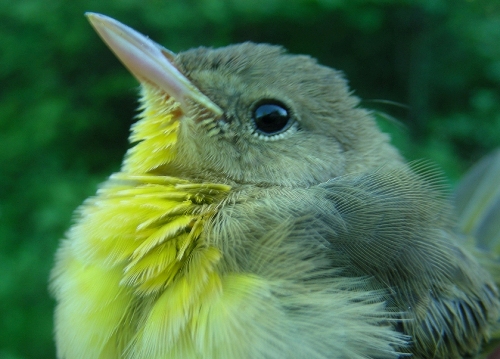 One of the focal points of the MAPS program is to document (via banding) locally hatched young, like this Common Yellowthroat that we’ll be looking for next year in case it decides to return to MBO. (Photo by Simon Duval)
One of the focal points of the MAPS program is to document (via banding) locally hatched young, like this Common Yellowthroat that we’ll be looking for next year in case it decides to return to MBO. (Photo by Simon Duval)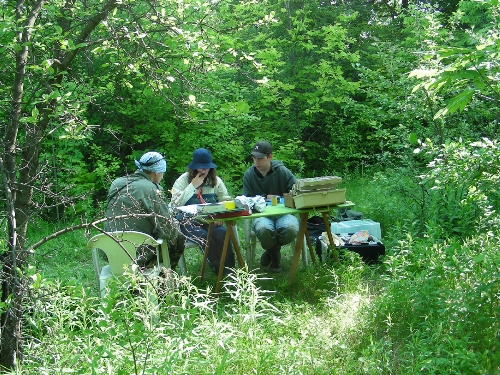 Because the MAPS nets are around the south end of Stoneycroft Pond, it made no sense to traipse back to the usual banding cabin after every net round. Rather, a base of field operations was established in a little clearing off the census trail (above), though working entirely outside did require volunteers to put on an extra layer of "armour" against the hordes of insects present for much of the season (below) (Photos by Gay Gruner)
Because the MAPS nets are around the south end of Stoneycroft Pond, it made no sense to traipse back to the usual banding cabin after every net round. Rather, a base of field operations was established in a little clearing off the census trail (above), though working entirely outside did require volunteers to put on an extra layer of "armour" against the hordes of insects present for much of the season (below) (Photos by Gay Gruner) 
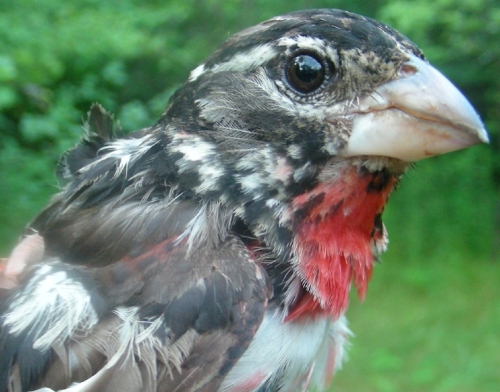 As a program focused on the breeding season, MAPS is also particularly good at documenting the annual (hopefully) return of adults to breeding sites. This rather scruffy second-year male Rose-breasted Grosbeak was caught in the early stages of his prebasic moult; if he returns next year he’ll be a much sleeker black, white, and red. (Photo by Gay Gruner)
As a program focused on the breeding season, MAPS is also particularly good at documenting the annual (hopefully) return of adults to breeding sites. This rather scruffy second-year male Rose-breasted Grosbeak was caught in the early stages of his prebasic moult; if he returns next year he’ll be a much sleeker black, white, and red. (Photo by Gay Gruner)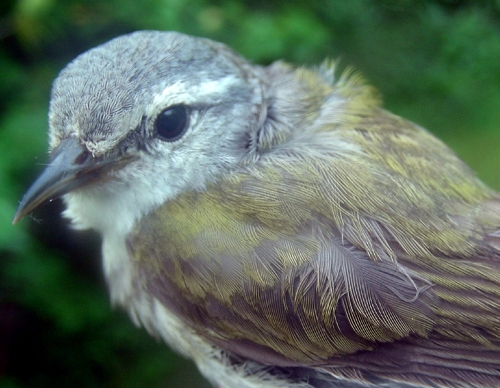 While the aim of MAPS is to document local breeders, the reality is that at our latitude there’s only a very brief period where migration ceases altogether, and it’s much shorter than the local nesting season. Adult Tennessee Warblers are generally our first fall migrant, beginning to arrive at MBO in mid/late July and often staying present for several weeks as they undergo their prebasic moult. (Photo by Gay Gruner)
While the aim of MAPS is to document local breeders, the reality is that at our latitude there’s only a very brief period where migration ceases altogether, and it’s much shorter than the local nesting season. Adult Tennessee Warblers are generally our first fall migrant, beginning to arrive at MBO in mid/late July and often staying present for several weeks as they undergo their prebasic moult. (Photo by Gay Gruner)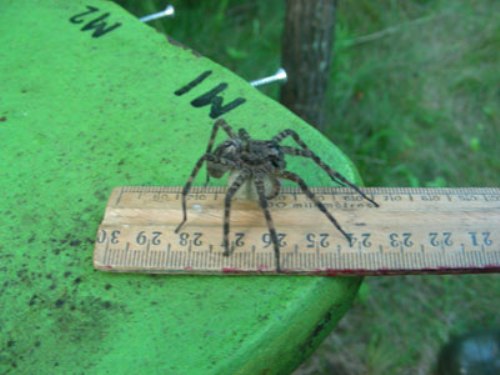 In addition to all the tiny annoying mosquitoes and flies, volunteers also had to deal with some distinctly larger critters at the banding table. (Photo by Gay Gruner)
In addition to all the tiny annoying mosquitoes and flies, volunteers also had to deal with some distinctly larger critters at the banding table. (Photo by Gay Gruner)